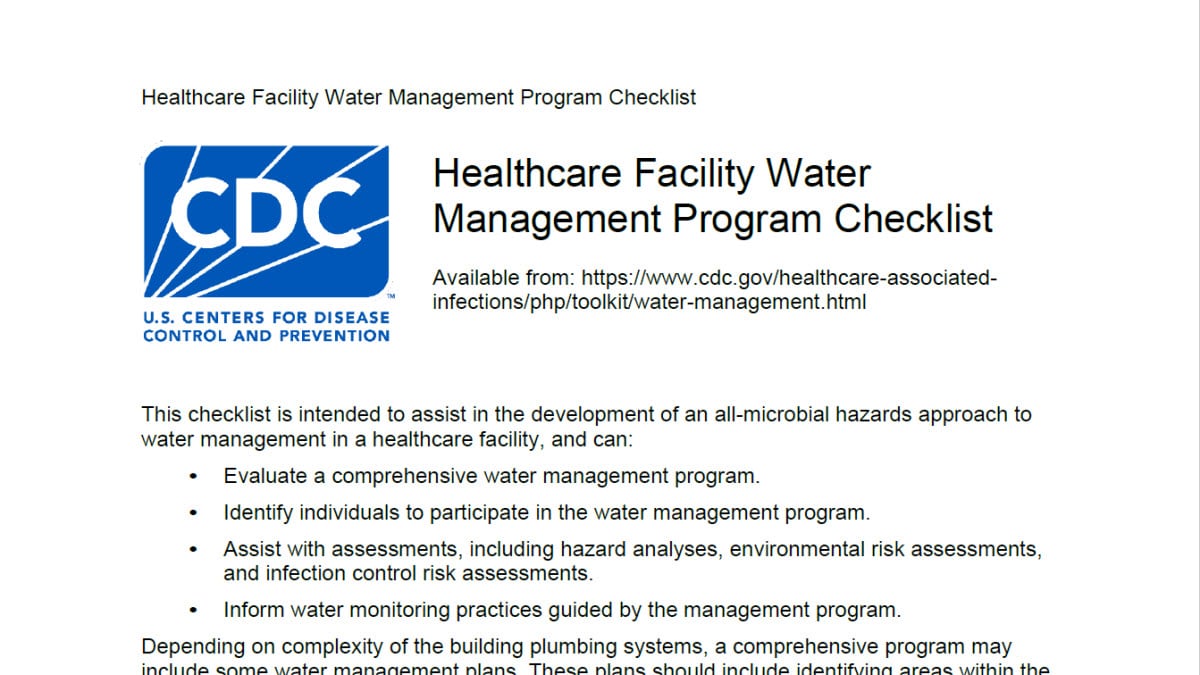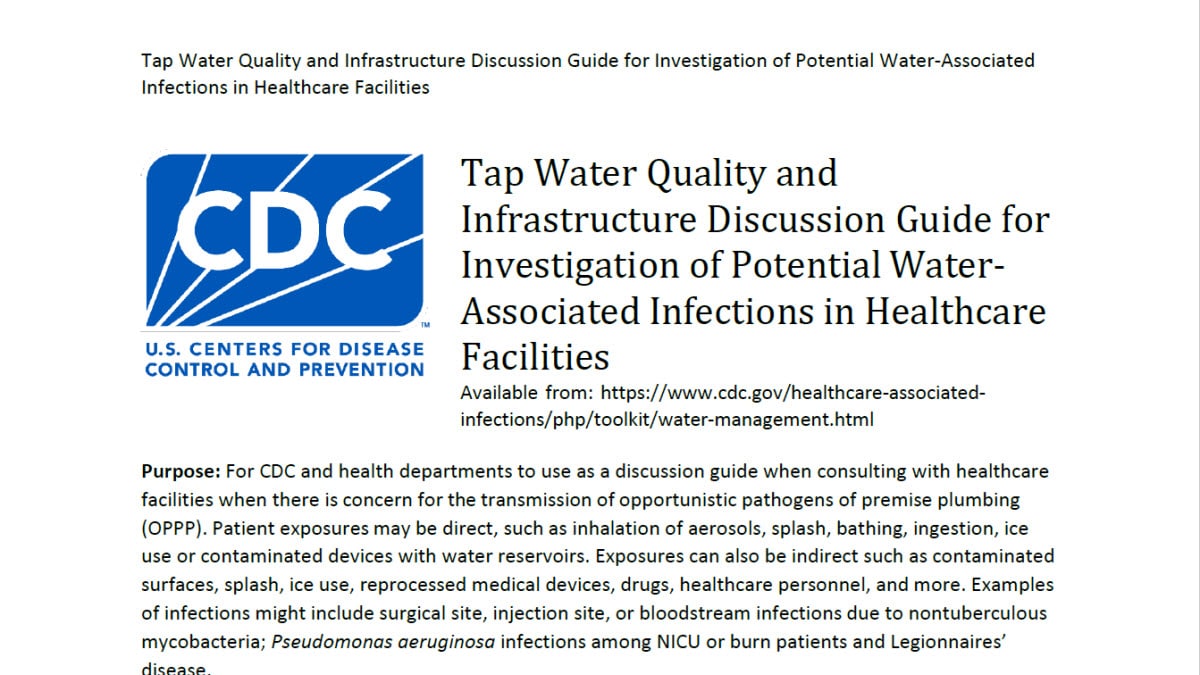Key points
- Water can carry germs that threaten patient safety and spread antimicrobial-resistant pathogens or cause healthcare-associated infections (HAIs).
- Healthcare facilities can reduce water-based risks through infection prevention practices and management of the building premise plumbing system.
Summary of considerations
- A healthcare water management program identifies both hazardous conditions and corrective actions that can minimize the growth and spread of waterborne pathogens in healthcare facilities.
- Healthcare facilities can use a Water Infection Control Risk Assessment (WICRA) to assess: water sources; mode of transmission; patient susceptibility; patient exposure; program preparedness.
- Healthcare facilities can reduce splashing from sinks and drains that can expose people to pathogens.
- When installing or modifying sinks, healthcare facilities can consider selecting designs that prevent splashing.
Purpose
From plumbing to patients
Tap water meets stringent safety standards in the United States, but it is not sterile. Germs may be present when water leaves the tap. For typical household uses, these germs rarely pose a serious health risk.
However, in healthcare settings, water uses are more varied, and patients are more vulnerable to infection. Certain plumbing conditions can even encourage microbial growth, leading to dangerously high levels of potential pathogens. Healthcare facilities must evaluate their water use for its risk to harbor and transmit healthcare-associated pathogens.
Patient safety depends on assuring that:
- Water entering a healthcare facility meets all quality standards. The following can impact a facility's water quality:
- System disruptions or pressure drops.
- Loss of disinfection residual such as low chlorine levels.
- Water main breaks.
- System disruptions or pressure drops.
- Premise plumbing is designed and maintained to minimize Opportunistic Pathogens of Premise Plumbing (OPPP) growth and spread in both the supply and wastewater systems. For example, they assess:
- The age and overall design of the system.
- Additions and renovations.
- Water age.
- Assuring there are no 'dead ends' where water can stagnate.
- The age and overall design of the system.
- Providers and staff minimize exposure risk through infection control practices, including practices specific to water.
Definitions
- Premise plumbing - the portion of a water system, including both hot and cold water, various devices (e.g., hot water heater, HVAC humidifier), fixtures (e.g., showers, faucets), and drains (e.g., sinks, toilets) connected to the main distribution system via service lines.
- Opportunistic Pathogens of Premise Plumbing (OPPP)- microorganisms in building water systems that are more likely to cause disease in at-risk or immunocompromised individuals.1
- Biofilm- collections of microorganisms that stick to each other and adhere to surfaces in moist environments, like the insides of pipes. It can last in drains for long periods of time and are often difficult or even impossible to remove.1
- Water age- the amount of time water might be in the piping system.
Maintain a water management program
Water management programs in healthcare facilities are an important way to help protect vulnerable patient populations as well as staff and visitors. The Centers for Medicare & Medicaid Services, The Joint Commission, The Veterans Health Administration, and CDC consider it essential that hospitals and nursing homes have a water management program that is aligned with American Society of Heating, Refrigerating and Air-Conditioning Engineers (ASHRAE) industry standards1 and limit OPPP from growing and spreading in their facility.
Elements of a healthcare water management program
- Multidisciplinary team that includes facility managers, infection prevention professionals, clinicians, administrators and/or a member from the local water utility.
- Building water systems description with flow diagrams.
- Evaluation of hazardous conditions where pathogens can grow and spread
- Control measures, their locations and how to monitor them.
- Interventions when control limits are not met.
- Ensure the program is running as designed and is effective.
- Documentation and communication on all activities.
Healthcare facilities can use the Healthcare Facility Water Management Program Checklist and the Tap Water Quality and Infrastructure Discussion Guide for Investigation of Potential Water-Associated Infections in Healthcare Facilities to help form their program if one does not already exist.
Conduct a water infection control risk assessment
Water management programs should consider the various pathways that might lead to patients becoming exposed to waterborne pathogens, in relation to ingestion, hygiene, and clinical care. Healthcare facilities can use a Water Infection Control Risk Assessment (WICRA) to evaluate water sources, modes of transmission, patient susceptibility, patient exposure, and program preparedness in their facilities.
Sinks and drains
Reduce exposure from sinks and drains
Splashes can occur when water hits the contaminated drain cover or a person flushes a toilet or hopper. Splashes can spread droplets containing OPPP to the surrounding environment, patients and providers.
Reduce the risk of OPPP exposure through sinks and drains in healthcare facilities
- Avoid placing patient care or personal items on counters next to sinks.
- Do not discard patient waste down sinks and minimize discarding beverages down sinks or toilets.
- Clean and disinfect surfaces daily near the drain such as the:
- Sink basin
- Faucet.
- Faucet handles.
- Surrounding countertop.
- Sink basin
- Consider using an EPA-registered biofilm disinfectant for wastewater drains during an outbreak.
- Close hopper and toilet lids before flushing. If lids are not available or allowed due to local plumbing codes, close any door that separates the hopper or toilet from other patient care areas.2
MDROs in Drains
Sink design
- When installing or modifying sinks, choose designs that prevent splashing and have adequate depth. 3
- Angle/offset faucets so they do not pour directly onto the drain.4
- Install splash guards on sinks next to medication preparation areas.
- Provide easy access to hand cleaning supplies.
- Facilities should monitor and regulate the water pressure used in patient care areas sinks so that splashing is minimized when the maximum water flow is used.3
Opportunistic Pathogens of Premise Plumbing
Gram negative bacteria
- Pseudomonas aeruginosa
- Pseudomonas putida
- Pseudomonas fluorescens
- Burkholderia cepcia complex (B. cepacia, B. cenocepacia, at least 8 other genomospecies)
- Cupriavidus (Ralstonia) pauculus
- Herbaspirillium
- Methylobacterium spp.
- Ralstonia pickettii, Ralstonia mannitolilytica
- Sphingomonas paucimobilis, Sphingomonas mucosissima, other Sphingomonas spp.
- Stenotrophomonas maltophilia
- Acinetobacter baumannii
- Acinetobacter calcoaceticus
- Alcaligenes xylosoxidans, A. faecalis
- Aeromonas hydrophila, Aeromonas spp.
- Elizabethkingia anopheles, E. meningosepticum
- Legionella pneumophila
Non-fecal coliforms
- Enterobacter cloacae
- Klebsiella spp.
- Pantoae agglomerans
- Rahnella aquatilis
- Serratia liquifaciens, Serratia marcescens
Nontuberculous mycobacteria (NTM or Environmental Mycobacteria)
- Mycobacterium. abscessus clade (M. abscessus, M. bolettii, M. massiliense)
- M. chelonae
- M. mucogenicum clade (M. mucogenicum, M. phociacum)
- M. fortuitum clade (M. fortuitum, M. cosmeticum, mageritiense, M. porcinum, M. septicum)
- M. immunogenum
- M. smegmatis clade (M. goodii, M. wolinskyi)
- M. aurum
- M. simiae
- M. avium complex (M. avium, M. intracellulare, M. chimaera, M avium ss hominissuis, M. columbiense)
- M. scrofulacuem
- M parascrofulaceum
- M. xenopi
- M. arupense
- M. kansasii
- M. haemophilum
- M. nonchromogenicum clade (M. nonchromogenicum, M. triviale, M. terrae)
- M. gordonae (only among patients with severe immune deficiency)
Other bacteria/actinomyces
- Microbacterium spp.
- Tsukamurella spp.
- Rhodococcus equi, Rhodococcus spp.
- Gordonae spp.
Fungi
- Yeasts (e.g., Candida parapsilosis, C. tropicalis)
- Aspergillus fumigatus, A. niger
- Fusarium spp.
- Exophiala spp.
Protozoa
- Acanthamoeba spp.
- Vermamoeba vermiformis
- Naegleria spp.
- American Society of Heating, Refrigerating and Air-Conditioning Engineers. 2023. ASHRAE/ANSI Standard 514, Risk Management for Building Water Systems: Physical, Chemical, and Microbial Hazards. Peachtree Corners, GA: ASHRAE
- Mathers, A. J., Vegesana, K., German Mesner, I., Barry, K. E., Pannone, A., Baumann, J., Crook, D. W., Stoesser, N., Kotay, S., Carroll, J., & Sifri, C. D. (2018). Intensive Care Unit Wastewater Interventions to Prevent Transmission of Multispecies Klebsiella pneumoniae Carbapenemase-Producing Organisms. Clinical infectious diseases : an official publication of the Infectious Diseases Society of America, 67(2), 171–178. https://doi.org/10.1093/cid/ciy052
- FGI Guideline for Hospitals A2.1-8.4.3.2 (1) a. https://fgiguidelines.org/wp-content/uploads/2022/03/2010_FGI_Guidelines.pdf
- Gestrich, S. A., Jencson, A. L., Cadnum, J. L., Livingston, S. H., Wilson, B. M., & Donskey, C. J. (2018). A multicenter investigation to characterize the risk for pathogen transmission from healthcare facility sinks. Infection control and hospital epidemiology, 39(12), 1467–1469. https://doi.org/10.1017/ice.2018.191


